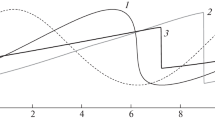Abstract
A new shock-capturing method is proposed which is based on upwind schemes and flux-vector splittings. Firstly, original upwind schemes are projected along characteristic directions. Secondly, the amplitudes of the characteristic decompositions are carefully controlled by limiters to prevent non-physical oscillations. Lastly, the schemes are converted into conservative forms, and the oscillation-free shock-capturing schemes are acquired. Two explicit upwind schemes (2nd-order and 3rd-order) and three compact upwind schemes (3rd-order, 5th-order and 7th-order) are modified by the method for hyperbolic systems and the modified schemes are checked on several one-dimensional and two-dimensional test cases. Some numerical solutions of the schemes are compared with those of a WENO scheme and a MP scheme as well as a compact-WENO scheme. The results show that the method with high order accuracy and high resolutions can capture shock waves smoothly.
Similar content being viewed by others
References
Harten A. High resolution schemes for hypersonic conservation laws[J]. Journal of Computational Physics, 1983, 49(2):367–393.
Roe P L. Approximate Riemann solvers, parameter vectors and difference schemes[J]. Journal of Computational Physics, 1981, 43(2):357–372.
Liou M S. A sequel to AUSM: AUSM+[J]. Journal of Computational Physics, 1996, 129(2):364–382.
Harten A, Osher S. Uniformly high-order accurate non-oscillatory schemes I[J]. SIAM Journal on Numerical Analysis. 1987, 24(2):279–309.
Shu C W, Osher S. Efficient implementation of essentially non-oscillatory shock capturing schemes[J]. Journal of Computational Physics, 1988, 77(2):439–471.
Jiang G S, Shu C W. Efficient implementation of weighted ENO schemes[J]. Journal of Computational Physics, 1996, 126(1):202–228.
Daru V, Tenaud C. High order one step monotonicity-preserving schemes for unsteady compressible flow calculations[J]. Journal of Computational Physics, 2004, 193(2):563–594.
Tu Guohua, Yuan Xiangjiang, Xia Zhiqiang, et al. A class of compact upwind TVD difference schemes[J]. Applied Mathematics and Mechanics (English Edition), 2006, 27(6):765–772.
Ravichandran K S. Higher order KFVS algorithms using compact upwind difference operators[J]. Journal of Computational Physics, 1997, 230(2):161–173.
Tu Guohua, Luo Junrong. Improve compact schemes by limiting flux method[J]. Chinese Journal of Computational Physics, 2005, 22(4):40–47 (in Chinese).
Ren Y X, Liu M, Zhang H. A characteristic-wise hybrid compact-WENO schemes for solving hyperbolic conservations[J]. Journal of Computational Physics, 2003, 192(2):365–386.
Author information
Authors and Affiliations
Corresponding author
Additional information
Communicated by LU Chuan-jing
Project supported by the National Natural Science Foundation of China (Nos.10321002 and 10672012)
Rights and permissions
About this article
Cite this article
Tu, Gh., Yuan, Xj. & Lu, Lp. Developing shock-capturing difference methods. Appl Math Mech 28, 477–486 (2007). https://doi.org/10.1007/s10483-007-0408-z
Received:
Revised:
Issue Date:
DOI: https://doi.org/10.1007/s10483-007-0408-z



